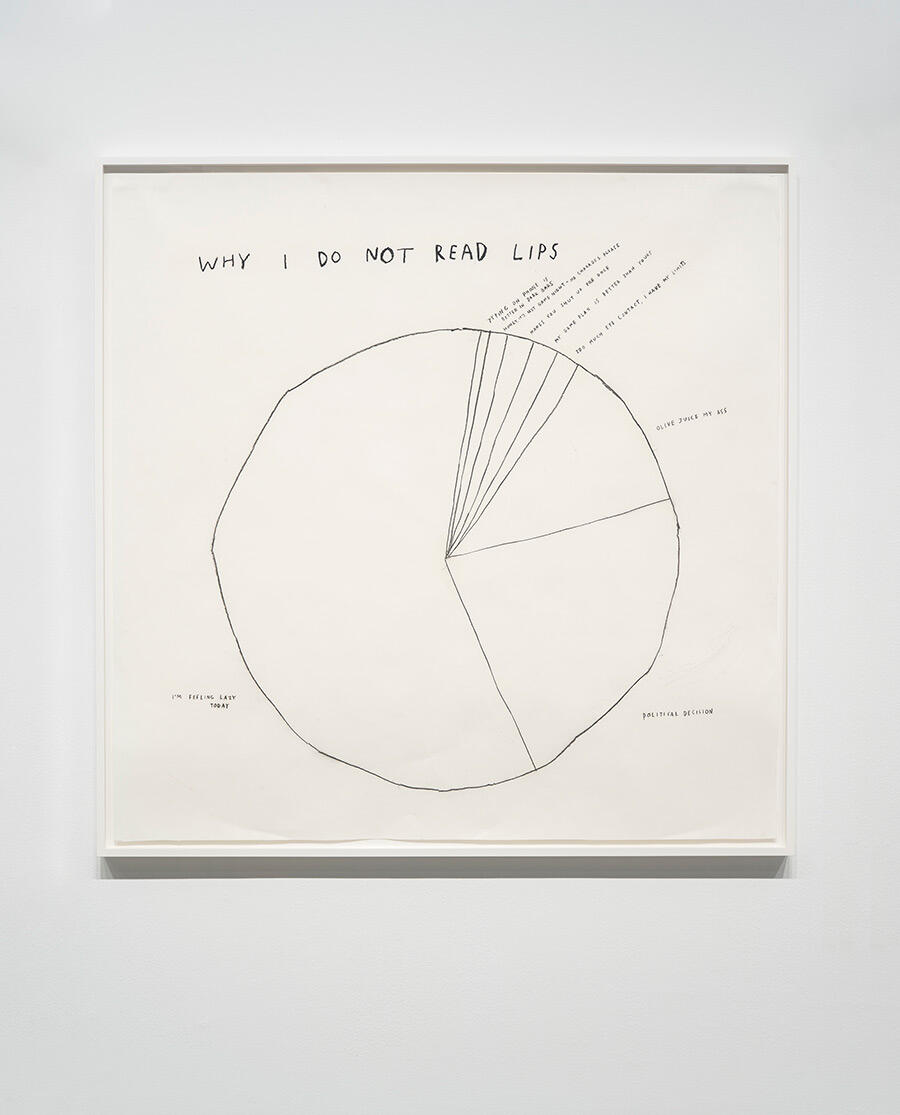Christine Sun Kim on Breaking the Echo Chamber
Emily McDermott profiles the artist and reflects on an arts practice that transcends boundaries of language and cultural identity
Emily McDermott profiles the artist and reflects on an arts practice that transcends boundaries of language and cultural identity

We live in a world that privileges sound, that emphasizes audible interactions and aurally based experiences, but California-born, Berlin-based artist Christine Sun Kim works to counter this socially ingrained emphasis. Through a variety of media – ranging from charcoal and oil-pastel drawings to videos and animations to murals and large-scale installations – the artist recalibrates the viewer’s perception of and associations with sound, particularly in regard to communication.
Kim was born Deaf and her practice is underlined by her experiences of living in a world that operates predominantly without consideration of the Deaf community. What makes her work resonate on a broader scale, however, is her use of such experiences to illuminate societal patterns of behaviour and methods of exclusion. A series of charcoal drawings of pie charts from 2018 breaks down the reasonings behind decisions she’s made, indicated by the works’ individual titles: Why My Hearing Daughter Signs (‘IT WOULD BE LAME IF HER DAD WOULD HAVE TO INTERPRET FOR US’), Why I Do Not Read Lips (‘I’M FEELING LAZY TODAY’, ‘POLITICAL DECISION’) and Why I Watch With Closed Captions (‘GOOD FOR RAP BATTLES’, ‘TO ANNOY THE SHIT OUT OF ASSHOLES WHO THINK CAPTIONS RUIN THE PICTURE’). Another series of charcoal drawings, ‘Degrees of Deaf Rage’ (2018), uses variously sized angles to address situations she’s encountered in educational settings, institutions, the artworld and more. For instance, Degrees of My Deaf Rage in the Art World (2018) features six angles, each accompanied by a phrase and a corresponding level of rage. An angle of around 240 degrees, labelled ‘REFLEX RAGE’, reads: ‘CURATORS WHO THINK IT’S FAIR TO SPLIT MY SALARY FEE WITH INTERPRETERS’. Next to it, a 360-degree circle, labelled ‘FULL ON RAGE’, reads: ‘MUSEUMS WITH ZERO DEAF PROGRAMMING (AND NO DEAF DOCENTS/EDUCATORS)’. These decisions and rages might be based on Kim’s personal experiences, but they point directly to societal and infrastructural pitfalls and, by using universal modes of communication such as humour and data visualization, the works transcend boundaries of language and cultural identity.

‘A lot of ideas that get developed in the Deaf community stay within the Deaf community,’ Kim told me recently over Zoom. And vice versa: if an ableist idea or societal norm is established in the hearing world, it often stays that way, repeating and ingraining problematic patterns and rhetoric. Kim’s mural brings such echoes into the spotlight and, in turn, asks the question of when and how we can escape – or perhaps rather break – the trap.
This mural led Kim to create a series of drawings reflecting on the echo, while, at the same time, she began thinking about the concept of debt – itself a vicious cycle of borrowing and owing, a financial echo chamber. As a US citizen who has lived in Germany for nine years, Kim’s own perception of debt has shifted: firstly, she was able to pay off her student loans and experience, for the first time in her adult life, financial freedom; secondly, she realized many Germans have never been in debt, unlike in the US, where approximately 80 percent of adults are. On a more conceptual level, the words ‘debt’ and ‘owe’ share the same sign in ASL, creating a repetition of movements and, sometimes, a potential confusion of meanings. Her new works explore these overlaps through visualizing the signs, replicating, zooming in on or even truncating them, and pairing them with phrases like ‘impt cool’ – the Deaf way to say, mostly to oneself: ‘Stay calm,’ or ‘Keep your cool.’

Works focused on debt and its many echoes will define Kim’s forthcoming solo show at JTT in New York. Some drawings will feature hands – a trope she had largely avoided up until recently in fear of it being too ‘obvious’ or pigeonholing the interpretations of and discussions surrounding her work. It’s a shift that asserts her confidence in her practice and her career development, as well as her understanding of her role as both an artist and activist for the Deaf community. It’s also an evolution that feels natural, following her exploration of the visuality of ASL in relation to debt and echo.

Whether through universal modes of communication, plays on language, conceptual notations or, as is most often the case, a combination thereof, Kim ‘want[s] to connect with all kinds of people, not just hearing people, not just Deaf people’, she tells me. And, with her work, which not only appears in galleries and museums but in public spaces internationally, she wants the world to ‘think about Deaf people every day. I want [us] to be in your face, because I want [us] to be part of society, I want [us] to be an everyday thing, I want [us] to be thought of. I want [us] to be normalized.’
The conversation with Christine Sun Kim for this article was interpreted by Beth Staehle.
This article first appeared in frieze issue 230 with the headline ‘Echo Chamber’.
Main Image: Christine Sun Kim, Echo Trap, 2021. Mural, dimensions adaptable. Installation view, MMK Frankfurt, Frankfurt, Germany, 2021. Courtesy: the artist, MMK Frankfurt and François Ghebaly Gallery; photograph: Axel Schneider
























